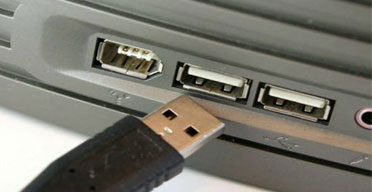NAIROBI, Kenya, May 4 – Heavy digital content developers frustrated with slow USB2 data transfer rates of 480 Megabits per second or costly, specialised ‘high transfers’ computer configurations have a reason to smile.
As technology innovation forges ahead, new kinds of devices, media formats, and large inexpensive storage are converging. More capacity is needed to cope with interactive experience of users’ expectations.
User applications demand a higher performance connection between the PC and these increasingly sophisticated peripherals. USB 3.0 addresses this need by adding an even higher transfer rate to match these new usage and devices.
Expected in months is “Superspeed USB3.0” that combines physical copper contacts with fibre optic signal to deliver up to 4.8 Gbit/sec data transfer rate. It means copying up to thirty-20 MB raw files in one second – ten times current USB2 or six times faster than FireWire 800 cable.
For “backward compatibility”with USB2 legacy devices, USB 3.0 cables will have extra contacts. One end of the cable can be plugged to USB2 devices connection while the other is designed for new US3 sockets. Unfortunately it is not compatible with USB1.
Local Content Development:
Slow USB2 video transfers between camera and computers forced many animation, video, and movie editor professionals to turn to Firewire and faster SATA cables to reduce wasted file transfers time and increased productivity.
Josh Jingo is a local digital artist who runs Pixelvue dot net – an animating, gaming, music creation and video production company. Pixelvue creates 3D animations for commercials and broadcast intros, outros and transitions, website designs, flash ads and interactive flash developers.
He avoids USB cables: “I don’t use USB.I tried it once, it was slow, and so I never bothered going further. SATA is taking shape and replacing Firewire in the video world. I haven’t used it much but I know it is faster than both USB and FireWire [cables].” Ideal speed? “Something like 2 Gigabyte per second would be awesome,” he adds.
Hardware and Software Industry:
Apple Inc. and other patent holders charged royalties of Sh20 for every end-user system and Sh80-160 to hardware that is needed to implement it, prevented FireWire cable from displacing USB in the mass-market. The royalties have since been dropped.
“As is customary, Apple remains silent on the issue of SuperSpeed USB support in MacOS X..If USB 3.0 realizes the promise of plug-and-play simplicity like USB 2.0 with dramatically increased speeds, the market for SuperSpeed devices will take off, and Apple will follow the trend. Whether or not this signals a threat to Firewire is not known, but you can be sure that Apple will need to support SuperSpeed if the rest of the industry adopts this interface standard,” says usb.org.
To differentiate, the new cable is blue inside while the current is white. And to take advantage of the faster USB 3.0 speeds new devices will be needed and a new controller for the computer.
It was first demonstrated at the Intel Developer Forum in 2007. Work on devices on this new standard was mostly suspended awaiting standardization on the controller interface – the thing that manages traffic on the system. Most vendors have traditionally followed Intel’s controller standard.
It saves them designing their own and being a standard, everything works the same way which makes USB much more worry free than other standards, for example, SCSI that came before it.
Promoters Revelations:
The ‘USB 3 Promoters Group’- HP, Intel, Microsoft, NEC, NXP, and Texas Instruments alludes that 6.28 billion USB devices were shipped since 2000 and 2.1 billion in 2006 alone.
At the SuperSpeed Developers Conference of last November, Microsoft announced that Windows 7 would support USB 3.0, perhaps not on its immediate release, but in a subsequent Service Pack or update. With successful support in Windows 7, support could trickle down to Vista.
Microsoft confirms it by stating that majority of their partners opine Vista should also support USB 3.0, but support on Windows XP remains unknown.
The standard, currently available under non-disclosure agreement, organizations are forbidden to ship code because it might reveal or imply what is in the specification. But once the standard is made public and with the open-source community behind it, Linux will most definitely support USB 3.0.
The Linux USB stack would have to be updated to add support for USB 3.0 details such as bus speed, power management, and a slew of other significant changes detailed in the USB 3.0 specification.
FireWire and Future:
Even as USB has become increasingly common, some still prefer FireWire, technically known as IEEE 1394. Most FireWire currently run at 400 megabits per second, but there are FireWire 800 devices at double that.
The IEEE (Institute of Electrical and Electronics Engineers) has never been big on catchy names. In a likely effort to keep up with USB development, last July they announced a speed upgrade dubbed “IEEE 1394-2008”.
“ExpressCard 2.0 Wholeheartedly Welcomes USB 3.0” says an online article dated November 18, 2008. And the official PCMCIA group promise that the standard would be released as soon as new USB specifications are published.
Presumably, SuperSpeed USB-equipped laptops will inherently come with ExpressCard 2.0 slots when they start shipping in 2010. We can’t wait to see the first SSD that works on both ExpressCard slot and USB 3.0 port as “going to be one killer application.”
SuperSpeed USB brings significant performance enhancements to the ubiquitous USB standard, while remaining compatible with the billions of USB enabled devices currently deployed in the market. It will deliver high transfer rate and improved power efficiency.
USB continues to answer connectivity for computers, Consumer Electronics, and Mobile architectures. Its fast, bidirectional, low-cost, dynamically attachable interface is consistent with the requirements of the computer platforms of today and tomorrow.



































